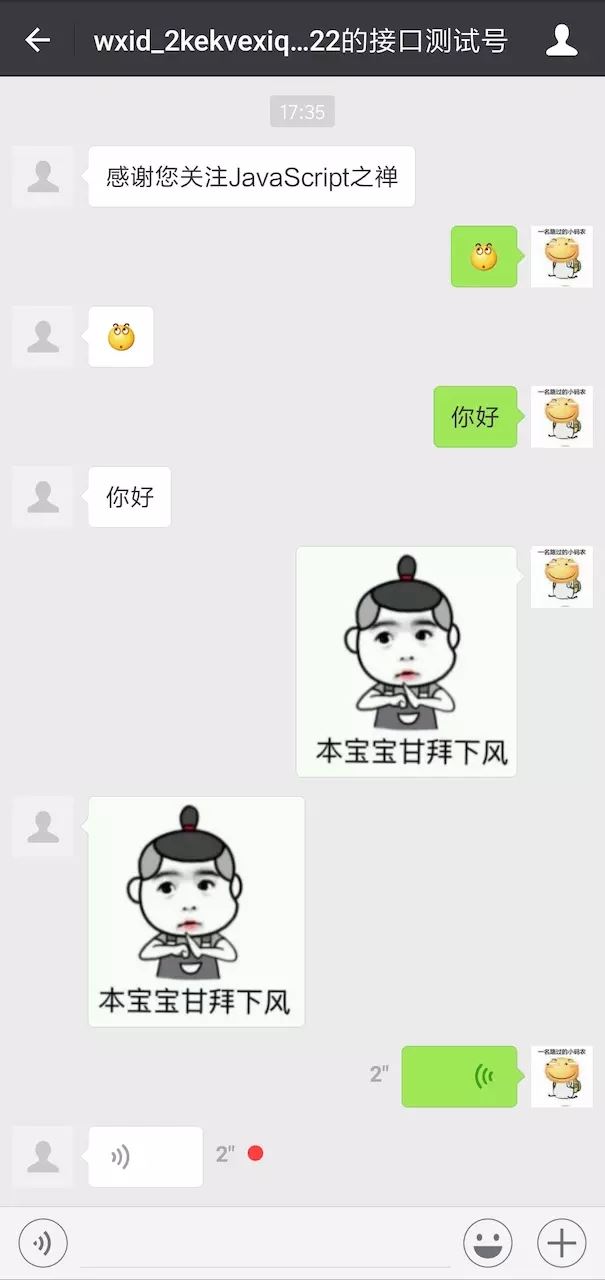您好,登錄后才能下訂單哦!
您好,登錄后才能下訂單哦!
這篇文章將為大家詳細講解有關Koa2微信公眾號開發之消息管理的示例分析,小編覺得挺實用的,因此分享給大家做個參考,希望大家閱讀完這篇文章后可以有所收獲。
接收消息
當普通微信用戶向公眾賬號發消息時,微信服務器將POST消息的XML數據包到開發者填寫的URL上。
接收普通消息數據格式
XML的結構基本固定,不同的消息類型略有不同。
用戶發送文本消息時,微信公眾賬號接收到的XML數據格式如下所示:
<xml> <ToUserName><![CDATA[toUser]]></ToUserName> <FromUserName><![CDATA[fromUser]]></FromUserName> <CreateTime>createTime</CreateTime> <MsgType><![CDATA[text]]></MsgType> <Content><![CDATA[this is a test]]></Content> <MsgId>1234567890123456</MsgId> </xml>
用戶發送圖片消息時,微信公眾賬號接收到的XML數據格式如下所示:
<xml> <ToUserName><![CDATA[toUser]]></ToUserName> <FromUserName><![CDATA[fromUser]]></FromUserName> <CreateTime>1348831860</CreateTime> <MsgType><![CDATA[image]]></MsgType> <PicUrl><![CDATA[this is a url]]></PicUrl> <MediaId><![CDATA[media_id]]></MediaId> <MsgId>1234567890123456</MsgId> </xml>
其他消息消息類型的結構請查閱【微信公眾平臺開發文檔】
對于POST請求的處理,koa2沒有封裝獲取參數的方法,需要通過自己解析上下文context中的原生node.js請求對象request。我們將用到row-body這個模塊來拿到數據。
先來優化之前的代碼
這一節的代碼緊接著上一屆實現的代碼,在上一屆的基礎上輕微改動了下。
'use strict'
const Koa = require('koa')
const app = new Koa()
const crypto = require('crypto')
// 將配置文件獨立到config.js
const config = require('./config')
app.use(async ctx => {
// GET 驗證服務器
if (ctx.method === 'GET') {
const { signature, timestamp, nonce, echostr } = ctx.query
const TOKEN = config.wechat.token
let hash = crypto.createHash('sha1')
const arr = [TOKEN, timestamp, nonce].sort()
hash.update(arr.join(''))
const shasum = hash.digest('hex')
if (shasum === signature) {
return ctx.body = echostr
}
ctx.status = 401
ctx.body = 'Invalid signature'
} else if (ctx.method === 'POST') { // POST接收數據
// TODO
}
});
app.listen(7001);這兒我們在只在GET中驗證了簽名值是否合法,實際上我們在POST中也應該驗證簽名。
將簽名驗證寫成一個函數
function getSignature (timestamp, nonce, token) {
let hash = crypto.createHash('sha1')
const arr = [token, timestamp, nonce].sort()
hash.update(arr.join(''))
return hash.digest('hex')
}優化代碼,再POST中也加入驗證
...
app.use(async ctx => {
const { signature, timestamp, nonce, echostr } = ctx.query
const TOKEN = config.wechat.token
if (ctx.method === 'GET') {
if (signature === getSignature(timestamp, nonce, TOKEN)) {
return ctx.body = echostr
}
ctx.status = 401
ctx.body = 'Invalid signature'
}else if (ctx.method === 'POST') {
if (signature !== getSignature(timestamp, nonce, TOKEN)) {
ctx.status = 401
return ctx.body = 'Invalid signature'
}
// TODO
}
});
...到這兒我們都沒有開始實現接受XML數據包的功能,而是在修改之前的代碼。這是為了演示在實際開發中的過程,寫任何代碼都不是一步到位的,好的代碼都是改出來的。
2.3 接收公眾號普通消息的XML數據包
現在開始進入本節的重點,接受XML數據包并轉為JSON
$ npm install raw-body --save
...
const getRawBody = require('raw-body')
...
// TODO
// 取原始數據
const xml = await getRawBody(ctx.req, {
length: ctx.request.length,
limit: '1mb',
encoding: ctx.request.charset || 'utf-8'
});
console.log(xml)
return ctx.body = 'success' // 直接回復success,微信服務器不會對此作任何處理給你的測試號發送文本消息,你可以在命令行看見打印出如下數據
<xml> <ToUserName><![CDATA[gh_9d2d49e7e006]]></ToUserName> <FromUserName><![CDATA[oBp2T0wK8lM4vIkmMTJfFpk6Owlo]]></FromUserName> <CreateTime>1516940059</CreateTime> <MsgType><![CDATA[text]]></MsgType> <Content><![CDATA[JavaScript之禪]]></Content> <MsgId>6515207943908059832</MsgId> </xml>
恭喜,到此你已經可以接收到XML數據了。? 但是我們還需要將XML轉為JSON方便我們的使用,我們將用到xml2js這個包
$ npm install xml2js --save
我們需要寫一個解析XML的異步函數,返回一個Promise對象
function parseXML(xml) {
return new Promise((resolve, reject) => {
xml2js.parseString(xml, { trim: true, explicitArray: false, ignoreAttrs: true }, function (err, result) {
if (err) {
return reject(err)
}
resolve(result.xml)
})
})
}接著調用parseXML方法,并打印出結果
... const formatted = await parseXML(xml) console.log(formatted) return ctx.body = 'success'
一切正常的話*(實際開發中你可能會遇到各種問題)*,命令行將打印出如下JSON數據
{ ToUserName: 'gh_9d2d49e7e006',
FromUserName: 'oBp2T0wK8lM4vIkmMTJfFpk6Owlo',
CreateTime: '1516941086',
MsgType: 'text',
Content: 'JavaScript之禪',
MsgId: '6515212354839473910' }到此,我們就能處理微信接收到的消息了,你可以自己測試關注、取消關注、發送各種類型的消息看看這個類型的消息所對應的XML數據格式都是怎么樣的
回復消息
當用戶發送消息給公眾號時(或某些特定的用戶操作引發的事件推送時),會產生一個POST請求,開發者可以在響應包(Get)中返回特定XML結構,來對該消息進行響應(現支持回復文本、圖片、圖文、語音、視頻、音樂)。嚴格來說,發送被動響應消息其實并不是一種接口,而是對微信服務器發過來消息的一次回復。
被動回復用戶消息數據格式
前面說了交互的數據格式為XML,接收消息是XML的,我們回復回去也應該是XML。
微信公眾賬號回復用戶文本消息時的XML數據格式如下所示:
<xml> <ToUserName><![CDATA[toUser]]></ToUserName> <FromUserName><![CDATA[fromUser]]></FromUserName> <CreateTime>12345678</CreateTime> <MsgType><![CDATA[text]]></MsgType> <Content><![CDATA[你好]]></Content> </xml>
微信公眾賬號回復用戶圖片消息時的XML數據格式如下所示:
<xml> <ToUserName><![CDATA[toUser]]></ToUserName> <FromUserName><![CDATA[fromUser]]></FromUserName> <CreateTime>12345678</CreateTime> <MsgType><![CDATA[image]]></MsgType> <Image><MediaId><![CDATA[media_id]]></MediaId></Image> </xml>
篇幅所限就不一一列舉了,請查閱【微信公眾平臺開發文檔】
前面的代碼都是直接回復success,不做任何處理。先來擼一個自動回復吧。收到消息后就回復這兒是JavaScript之禪
// return ctx.body = 'success' // 直接success
ctx.type = 'application/xml'
return ctx.body = `<xml>
<ToUserName><![CDATA[${formatted.FromUserName}]]></ToUserName>
<FromUserName><![CDATA[${formatted.ToUserName}]]></FromUserName>
<CreateTime>${new Date().getTime()}</CreateTime>
<MsgType><![CDATA[text]]></MsgType>
<Content><![CDATA[這兒是JavaScript之禪]]></Content>
</xml>`使用ejs模板引擎處理回復內容
從這一小段代碼中可以看出,被動回復消息就是把你想要回復的內容按照約定的XML格式返回即可。但是一段一段的拼XML那多麻煩。我們來加個模板引擎方便我們處理XML。模板引擎有很多,ejs 是其中一種,它使用起來十分簡單
首先下載并引入ejs
$ npm install ejs --save
如果你之前沒用過現在只需要記住下面這幾個語法,以及ejs.compile()方法
<% code %>:運行 JavaScript 代碼,不輸出
<%= code %>:顯示轉義后的 HTML內容
<%- code %>:顯示原始 HTML 內容
可以先看看這個ejs的小demo:
const ejs = require('ejs')
let tpl = `
<xml>
<ToUserName><![CDATA[<%-toUsername%>]]></ToUserName>
<FromUserName><![CDATA[<%-fromUsername%>]]></FromUserName>
<CreateTime><%=createTime%></CreateTime>
<MsgType><![CDATA[<%=msgType%>]]></MsgType>
<Content><![CDATA[<%-content%>]]></Content>
</xml>
`
const compiled = ejs.compile(tpl)
let mess = compiled({
toUsername: '1234',
fromUsername: '12345',
createTime: new Date().getTime(),
msgType: 'text',
content: 'JavaScript之禪',
})
console.log(mess)
/* 將打印出如下信息
*================
<xml>
<ToUserName><![CDATA[1234]]></ToUserName>
<FromUserName><![CDATA[12345]]></FromUserName>
<CreateTime>1517037564494</CreateTime>
<MsgType><![CDATA[text]]></MsgType>
<Content><![CDATA[JavaScript之禪]]></Content>
</xml>
*/現在來編寫被動回復消息的模板,各種if else,這兒就直接貼代碼了
<xml>
<ToUserName><![CDATA[<%-toUsername%>]]></ToUserName>
<FromUserName><![CDATA[<%-fromUsername%>]]></FromUserName>
<CreateTime><%=createTime%></CreateTime>
<MsgType><![CDATA[<%=msgType%>]]></MsgType>
<% if (msgType === 'news') { %>
<ArticleCount><%=content.length%></ArticleCount>
<Articles>
<% content.forEach(function(item){ %>
<item>
<Title><![CDATA[<%-item.title%>]]></Title>
<Description><![CDATA[<%-item.description%>]]></Description>
<PicUrl><![CDATA[<%-item.picUrl || item.picurl || item.pic || item.thumb_url %>]]></PicUrl>
<Url><![CDATA[<%-item.url%>]]></Url>
</item>
<% }); %>
</Articles>
<% } else if (msgType === 'music') { %>
<Music>
<Title><![CDATA[<%-content.title%>]]></Title>
<Description><![CDATA[<%-content.description%>]]></Description>
<MusicUrl><![CDATA[<%-content.musicUrl || content.url %>]]></MusicUrl>
<HQMusicUrl><![CDATA[<%-content.hqMusicUrl || content.hqUrl %>]]></HQMusicUrl>
</Music>
<% } else if (msgType === 'voice') { %>
<Voice>
<MediaId><![CDATA[<%-content.mediaId%>]]></MediaId>
</Voice>
<% } else if (msgType === 'image') { %>
<Image>
<MediaId><![CDATA[<%-content.mediaId%>]]></MediaId>
</Image>
<% } else if (msgType === 'video') { %>
<Video>
<MediaId><![CDATA[<%-content.mediaId%>]]></MediaId>
<Title><![CDATA[<%-content.title%>]]></Title>
<Description><![CDATA[<%-content.description%>]]></Description>
</Video>
<% } else { %>
<Content><![CDATA[<%-content%>]]></Content>
<% } %>
</xml>現在就可以使用我們寫好的模板回復XML消息了
...
const formatted = await parseXML(xml)
console.log(formatted)
let info = {}
let type = 'text'
info.msgType = type
info.createTime = new Date().getTime()
info.toUsername = formatted.FromUserName
info.fromUsername = formatted.ToUserName
info.content = 'JavaScript之禪'
return ctx.body = compiled(info)我們可以把這個回復消息的功能寫成一個函數
function reply (content, fromUsername, toUsername) {
var info = {}
var type = 'text'
info.content = content || ''
// 判斷消息類型
if (Array.isArray(content)) {
type = 'news'
} else if (typeof content === 'object') {
if (content.hasOwnProperty('type')) {
type = content.type
info.content = content.content
} else {
type = 'music'
}
}
info.msgType = type
info.createTime = new Date().getTime()
info.toUsername = toUsername
info.fromUsername = fromUsername
return compiled(info)
}在回復消息的時候直接調用這個方法即可
... const formatted = await parseXML(xml) console.log(formatted) const content = 'JavaScript之禪' const replyMessageXml = reply(content, formatted.ToUserName, formatted.FromUserName) return ctx.body = replyMessageXml
現在為了測試我們所寫的這個功能,來實現一個【學我說話】的功能:
回復音樂將返回一個音樂類型的消息,回復文本圖片,語音,公眾號將返回同樣的內容,當然了你可以在這個基礎上進行各種發揮。
....
const formatted = await parseXML(xml)
console.log(formatted)
let content = ''
if (formatted.Content === '音樂') {
content = {
type: 'music',
content: {
title: 'Lemon Tree',
description: 'Lemon Tree',
musicUrl: 'http://mp3.com/xx.mp3'
},
}
} else if (formatted.MsgType === 'text') {
content = formatted.Content
} else if (formatted.MsgType === 'image') {
content = {
type: 'image',
content: {
mediaId: formatted.MediaId
},
}
} else if (formatted.MsgType === 'voice') {
content = {
type: 'voice',
content: {
mediaId: formatted.MediaId
},
}
} else {
content = 'JavaScript之禪'
}
const replyMessageXml = reply(content, formatted.ToUserName, formatted.FromUserName)
console.log(replyMessageXml)
ctx.type = 'application/xml'
return ctx.body = replyMessageXmlnice,到此時我們的測試號已經能夠根據我們的消息做出相應的回應了

關于“Koa2微信公眾號開發之消息管理的示例分析”這篇文章就分享到這里了,希望以上內容可以對大家有一定的幫助,使各位可以學到更多知識,如果覺得文章不錯,請把它分享出去讓更多的人看到。
免責聲明:本站發布的內容(圖片、視頻和文字)以原創、轉載和分享為主,文章觀點不代表本網站立場,如果涉及侵權請聯系站長郵箱:is@yisu.com進行舉報,并提供相關證據,一經查實,將立刻刪除涉嫌侵權內容。